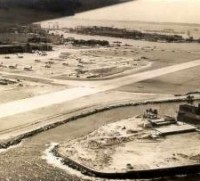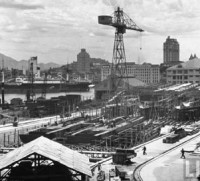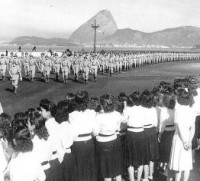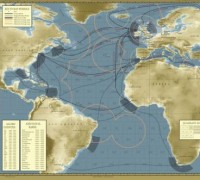BRAZIL THE FORGOTTEN ALLY - BRAZIL X USA
6)ORGANIZATION OF THE FEB
WHAT DID YOU DO IN THE WAR ZE CARIOCA?
By Frank Mc D. Cann. University of New Hampshire.
There was some difference of opinion between the Brazilians and Americans over which troops should be used to form the expeditionary force. The American military, and the Joint Brazil-United States Defense Commission, which had been set up to coordinate military relations, thought it logical to use the units in the Northeast, but the Brazilians looked at the 15,000 American personnel at bases in that region and thought differently. Minister Dutra wanted to build three regional training camps to prepare three divisions simultaneously, thereby creating valuable facilities for the postwar era.
But the United States could not provide the weapons and equipment necessary to outfit three camps, that is to say, 50% of the equipment for three divisions. Moreover, because neither Brazil nor the United States had enough ships to carry even one full division all at once, the Pentagon carne up with the idea of providing 50% of a division's equipment for training, which would be left behind for the training of each successive division. They would all be armed and equipped in the Theater of Operations.
Just before he visited the United States in August 1943, Minister of War Dutra, who wanted to command the planned corps, sounded out various generals as to their interest in leading one of the divisions. General Joáo Baptista Mascarenhas de Moraes, who had commanded the northeastern military region (the 7th) from June 1940 to January 1943, responded immediately, while the others hesitated. Eventually two other division commanders were designated and preparations begun, but the plans were not carried out, and the force was fixed at one division.
The Brazilian army of 1943 did not have standing divisions ready for intensified training and transportation, but rather was organized in static geographic regional commands which presided over dispersed regimentalized units. These, in turn, were quartered in barracks that often had scant room to receive additional mobilized troops, and little space for training of the sort the American army was then receiving. Moreover, most of the barracks were in urban areas. And because the troops were mainly drafted from the locality, to form a division from one region would place a politically unacceptable sacrifice on that region.
So the unwillingness to use northeastern units was related to more than worry about the American presence. To form the expeditionary division, units were called in from across the map of Brazil. On the negative side, this meant that these units were not accustomed to working together. On the positive side, planners argued that since the army had been trained and organized on a French model since 1919, it would be easier to shift to an American model if the division was composed of units which had no previous joint experience. Adaptation would be faster.
Oddly, instead of using the coming combat experience to enhance the professionalization of a maximum number of regular junior officers, the army called up a considerable number of reserve officers, many of whom were professional men in civilian life. Of the 870 infantry line officers in the force, at least 302 were reservists. Fortunately for historians, a group of them produced one of the most useful books on the expeditionary force.
It is not clear whether this was a political decision or a purely administrative one. But it does seem that there were not enough junior officers to staff the expeditionary force. Later, in Italy, referring to the shortage of military school graduates and to the professional deficiencies of the reserve officers, Mascarenhas requested, as late as April 1945, to commission sixty infantry sergeants to serve as platoon leaders.
There was also considerable difficulty filling the ranks of the designated units. Lacking military police units, the army took in policemen from Sáo Paulo's Força Publica, it created signal units with men from electric and telephone companies, and it organized a nursing detachment by public recruitment of interested women. The fact that draftees were being sent overseas persuaded many to escape service, but, since the draft was imposed in 1916, the army always had large numbers who evaded duty.
For example, in the 7th Military Region in Northeast Brazil, while Mascarenhas was commander, the 1941 call-up of 7898 men had an evasion rate of 48.9%, and of those who did present themselves, fully 41 % were medically unfit. Indeed, this was an improvement, the previous year the evasion rate had been 68%. Among the 3434 volunteers in that region, 2201 or 64% were found fit for service. These figures were fairly typical of the national experience. The rejection rate for medical and health reasons was high for both draftees and active duty troops.
In forming one of the later echelons, 18,000 soldiers in regular units were examined to obtain 6,000 men. In the case of the fourth echelon, the 10,000 active-duty soldiers examined netted only 4,500 physically fit for embarkation. I have discussed elsewhere in more detail the recruitment and medical examinations, suffice to say here that it was the nation's poor health that stalled the mobilization.
In January 1945, General Ralph Wooten observed that the Brazilian army was "near the bottom of the barree' in finding combat personnel and that it was "a mistake to expect any additional assistance from Brazil in this respect." The training functioned on multiple levels. Brazilian officers had been sent to the United States for courses since 1938, mostly in coast artillery and aviation. Indeed, in early 1941, well before Pearl Harbor, Brazil was sending groups of officers for training in a variety of specialties.
The pace continued to accelerate to the point where, by the end of 1944, somewhat over 1000 Brazilian military personnel had gone to the United States. The American army created a special Brazilian course at its Command and General Staff School at Fort Leavenworth, Kansas, that enrolled 259 officers, the largest contingent of any one foreign nation to pass through its classrooms. The school commandant said that the Brazilians, who had already completed their own three-year general staff course, "knew more than most of his instructors."
The troops sent to Italy in five echelons eventually totalled 25,334. In July 1944, the first echelon arrived in Naples. After some delays with equipment and training, on September 15, the 6th Infantry Regiment and support troops, under Brigadier General Euclydes Zenobio da Costa, went into the line of the Fourth Corps of the U.S. Fifth Army. Army commander, Mark Clark, decided on this partial commitment because he needed to beef up the Fourth Corps, that had dwindled to barely the level of a reinforced division because of units being detached for the Seventh Army's invasion of southern France in July.
The Fifth Army had lost fully seven divisions to the French operation, so the Brazilians' arrival at that moment was opportune. The American Fifth and British Eighth Armies were readying a drive on the German's Gothic Line, in an attempt to reach the Po Valley and Bologna before Christmas. The Fifth Army's three corps (from west to east: U.S. Fourth, U.S. Second, and British Twelfth) were to attack with the Second Corps as spearhead and the Fourth immobilizing and harassing the Germans before it. Clark thought that this would give the Brazilians a relatively smooth introduction to combat.
It is interesting to note the different reactions of the Brazilians and the Americans to the subsequent action. The Brazilians moved along nicely pursuing retreating German units from September 16 to October 30, when they suffered a sudden counterattack that they held back for about ten hours, until they ran short of ammunition and were forced to fall back. From the American records, we can see that this was perceived as a normal combat occurrence, but the accounts published by Brazilian officers are full of finger- pointing and acrimony.
On the scene, Mascarenhas blamed and reprimanded the troops for their lack of caution and fleeing before a Memoralized enemy." Of course, he was anxious that they do well, and he was still a bit inexperienced himself in the nature of this war. They had done about as well as anyone could have under the circumstances. The U.S. 92d Division which replaced them, when they moved over to the Reno Valley, was likewise unable to drive the Germans from the ridge line that they held for the next five months.

Brazilian Expeditionary Force camping outside Pisa.
Performance of the Expeditionary Force The expeditionary force's (FEB from here on) role was a tactical one; the bulk of its combat experience was at the platoon level. The division's combat diary is largely a summary of patrol actions, as was the case for the Fifth Army generally in the autumn and winter of 1944-45. The Brazilians recognized this; they did not claim that their role or its impact was strategic, although, with age, a few veterans have made that assertion. In his memoirs, the division's chief of staff, Floriano de Lima Brayner, observed that at "no time did the FEB engage in strategic level operations."
And after the war, to symbolize the level of the role they had played, the army erected a monument to the FEB lieutenants at the Academia Militar das Agulhas Negras. Indeed, it is difficult to imagine how one division could have played anything but a tactical role in the campaign in northern Italy.This point has been lost sight of by some observers, such as journalist William Waack, whose As duas faces da glória: A FEB vista pelos seus aliados e inimigos seems based on the premise that the Brazilians claimed a greater importance for the FEB than they actually did.
He contrasts some German veterans' lack of knowledge and remembrance of the Brazilian force and the sharp criticism of American liaison and inspection reports with the "grandiloquence" of Brazilian narratives on the FEB. The principal German division facing the Brazilians had a large number of very young and rather old soldiers, and was commanded by officers who had served long years and had survived the rigors of the Russian front.
Some of these men may have been worn out, but most were veterans who had immeasurably more combat experience than the Brazilians. Indeed, the FEB sailed from Brazil with most of its troops untrained. The officers were startled by the intense training program that the Americans insisted upon. The literature on the FEB makes much of its struggle to take an elevation called "Monte Castello" during the winter of 1944-45. In combat, everything is a matter of perspective and scale.
The front for an army commander is measured in miles, for a corps commander it is narrowed to a mountain ridge, for a division commander the focus is a hill, for a company commander the objective is part of the slope, for platoon leaders it is a matter of certain pillboxes and gun positions, and for the soldier it is the few feet and inches ahead of him. Each one experiences a different battle. The Italian campaign was brutal because the Allies had to fight continuously uphill to dislodge the Germans from commanding elevations.
When the FEB reached division strength in November, it took its place with the U.S. Fourth Corps in the mountains north of Florence and west of Bologna. The Fifth Army's objective was to break through the German's so-called Gothic Line and descend into the Po Valley to take Bologna. The Fourth Corps confronted an imposing mountain ridge known as Mt. Belvedere - Mt. Torraccia, from which German artillery and mortars could harrass traffic on the west to east highway #64, that cuts its narrow way through the mountains from Pistoia to Bologna.
It is difficult to imagine driving defenders from such a place. Just beyond the spa-town of Porretta Terme, the mountains open into a huge basin flanked by low elevations on its right and left, and blocked by the suddenly rising Belvedere-Torraccia to the front. On its left, the ridge is a sheer rock wall that appears smooth from a distance, to the right the ridge becomes jagged and broken, with a road winding upward around it off in the direction of Montese, a key point before descent into the Po Valley.
The American 92d "Black Buffalo" Division and then the l0th Mountain Division faced Belvedere. The FEB confronted a hill that juts out below the top of Torraccia. From that hill, the Germns could rake the lower slopes to the west (left) from well-prepared positions. That hill, which German maps labelled simply "101/19", was what local people called Monte Castello. Walking up it today is hardly even tiring, but going up it under artillery, machine-gun, mortar, and rifle fire would be suicidal.
Monte Castello held the Brazilians at bay in four assaults - November 24, 25, 29, December 12- before falling to them on February 21. They spent four out of their nine months of combat under its guns. The German defenders admired their stubbornness. After the failed December 12th assault in which the Brazilians suffered 145 casualties, compared with a German loss of 5 killed and 13 wounded, a German captain told a captured FEB lieutenant: "Frankly, you Brazilians are either crazy or very brave.
I never saw anyone advance against machine-guns and well-defended positions with such disregard for life ... You are devils." Though the elevation itself pales beside its neighbors, it became symbolic of the FEB's combat ability and, in a bigger sense, of Brazil's coming of age as a country to be taken seriously. The Rio newspaper, A Manhã, editorialized that "The young Brazilians who implanted the Brazilian banner on its summit will conquer for Brazil the place that it merits in the world of tomorrow."
Monte Castello was and is a minor elevation lost amidst some of the ruggedest terrain in Italy. It does not show up on large-scale maps of Italy and one has to search out local hiking maps to fmd it. It was not labelled clearly on American battle maps, and likely the German defenders did not even know its nature. In fact, in the FEB war diary, the first mention of that name was the day of its capture, February 21. It would be surprising if anyone besides the Brazilians remembered the nature.
Brazilian armoured car enters cautiously at Montese after a One brazilian armoured car enters the village of Montesse. Naturally they gave more importance to the natures of the terrain that they captured than did either the defending Germans or the Americans concerned with the broader front. The American liaison detachment diarist commented that "this feature had been the objective of two previous Brazilian attacks, in which they suffered considerable casualties, its capture was a distinct loss to the enemy, since it deprived him of his last good observation" point in the area.

One brazilian armored car enters at the village of Montese following a battle with heavily entrenched Germans.
After the war, the Brazilian veterans and the Brazilian army made much of Monte Castello. For them the battle had great symbolic importance. Their part in the capture of Belvedere-Castello convinced the Brazilians that they were up to the task that they had taken on. The fact is that the FEB and the U.S. l0th Mountain Division were effective in the joint operation which drove the Germans off important elevations that allowed the Allied spring offensive to move forward.
lf either of the two divisions had failed, that offensive would have been delayed. Relations between the Brazilian troops and the Americans were sometimes tense. It was awkward for the Brazilians to be totally dependent on the American forces for training, clothing, arms, equipment, and food. The American stress on training, training, and more training, even of frontline personnel, bemused the Brazilians. lt was a clash between two cultures, one that so believed in education that its army's terminology was drawn from the language of the school house, and the other that left most of its people unschooled.
The outcome was a successful example of coalition warfare, which always requires determined effort and understanding to blend national styles into a winning combination. But the FEB went beyond the standard idea of coalition warfare because of its total integration into the American army. It was not a colonial unit, as were the British Indian ones, or a Commonwealth military, such as the Canadian, New Zealander, or South African, nor a Free "this or that," such as the Polish or French contingents.
lt was a division from an army of an independent, sovereign state that voluntarily placed its men and women under United States command. The connection could not Nave been tighter and still have preserved the FEB's integrity of command and its Brazilian identity. It never lost either. The FEB completed all the missions confided to it and compared favorably with the American divisions of the Fourth Corps. Unfortunately, the heavy symbolism of Monte Castello has obscured the FEB's victory at Montese on April 16, in which it took the town after a four-day gruelling battle, suffering 426 casualties.
In the next days it fought to a standstill the German 148th Division and Fascist Italian Monte Rosa, San Marco, and Italia Divisions, which surrendered to General Mascarenhas on April 29-30. In a matter of days the Brazilians trapped and took the surrender of 2 generals, 800 officers, and 14,700 troops. The 148th was the only intact German division to surrender on that front.
Although they had little preparation and served under foreign command, against a combat-experienced enemy, the "Smoking Cobras," as the FEB was nicknamed, had shown, as one of their songs put it, the "fiber of the Brazilian army" and the "grandeza de nossa gente" (greatness of our people). American leaders wanted the FEB to stay in Europe as part of the occupation forces, but Brazilian military and civilian leaders rejected that role.
Unhappily, over American objections, the Brazilian government decided to disband the FEB upon return to Brazil. The American military had hoped that the division would be kept together to form the nucleus for a complete reformation of the Brazilian army. FEB veterans would slowly introduce the lessons of the war finto the General Staff School and Military School curricula. But the chance to use the FEB experience to project Brazilian influence on the post-war world order was lost.
Those making the rapid decisions in late 1945 that led to the FEB's demise could not know how quickly the United States would demobilize, or how quickly the alliance with the Soviet Union would collapse. Perhaps if Brazil had maintained occupation troops in Europe and a standing cadre of combat-hardened troops at home, it would have had a different post-war international position.



